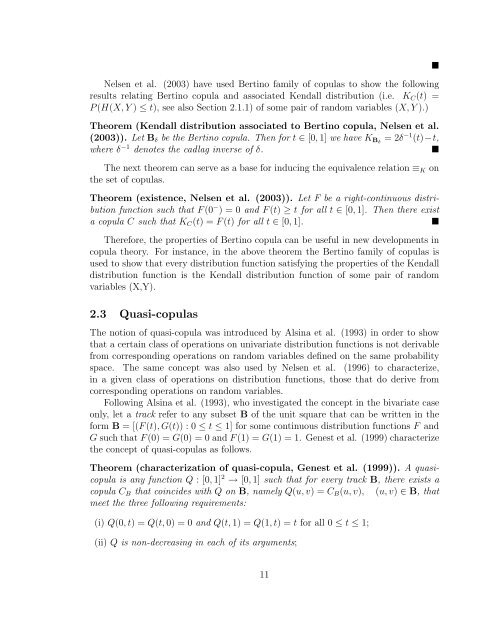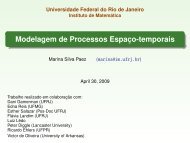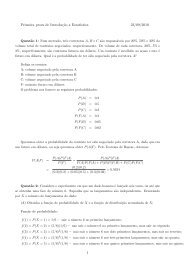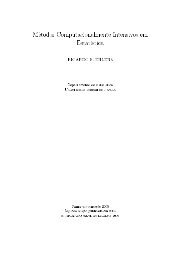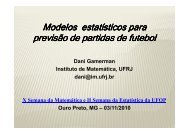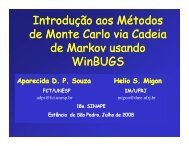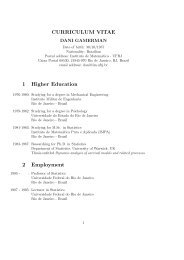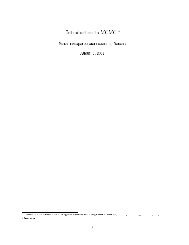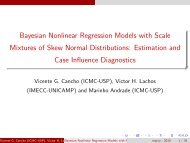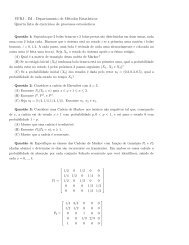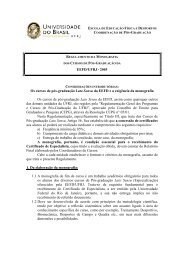Copulas: a Review and Recent Developments (2007)
Copulas: a Review and Recent Developments (2007)
Copulas: a Review and Recent Developments (2007)
Create successful ePaper yourself
Turn your PDF publications into a flip-book with our unique Google optimized e-Paper software.
Nelsen et al. (2003) have used Bertino family of copulas to show the followingresults relating Bertino copula <strong>and</strong> associated Kendall distribution (i.e. K C (t) =P (H(X; Y ) · t), see also Section 2.1.1) of some pair of r<strong>and</strong>om variables (X; Y ).)Theorem (Kendall distribution associated to Bertino copula, Nelsen et al.(2003)). Let B ± be the Bertino copula. Then for t 2 [0; 1] we have K B± =2± ¡1 (t)¡t,where ± ¡1 denotes the cadlag inverse of ±. ¥The next theorem can serve as a base for inducing the equivalence relation ´K onthe set of copulas.Theorem (existence, Nelsen et al. (2003)). Let F be a right-continuous distributionfunction such that F (0 ¡ )=0<strong>and</strong> F (t) ¸ t for all t 2 [0; 1]. Then there existacopulaC such that K C (t) =F (t) for all t 2 [0; 1]. ¥Therefore, the properties of Bertino copula can be useful in new developments incopula theory. For instance, in the above theorem the Bertino family of copulas isused to show that every distribution function satisfying the properties of the Kendalldistribution function is the Kendall distribution function of some pair of r<strong>and</strong>omvariables (X,Y).2.3 Quasi-copulasThe notion of quasi-copula was introduced by Alsina et al. (1993) in order to showthat a certain class of operations on univariate distribution functions is not derivablefrom corresponding operations on r<strong>and</strong>om variables de¯ned on the same probabilityspace. The same concept was also used by Nelsen et al. (1996) to characterize,in a given class of operations on distribution functions, those that do derive fromcorresponding operations on r<strong>and</strong>om variables.Following Alsina et al. (1993), who investigated the concept in the bivariate caseonly, let a track refer to any subset B of the unit square that can be written in theform B =[(F (t);G(t)) : 0 · t · 1] for some continuous distribution functions F <strong>and</strong>G such that F (0) = G(0) = 0 <strong>and</strong> F (1) = G(1) = 1. Genest et al. (1999) characterizethe concept of quasi-copulas as follows.Theorem (characterization of quasi-copula, Genest et al. (1999)). A quasicopulais any function Q :[0; 1] 2 ! [0; 1] such that for every track B, thereexistsacopula C B that coincides with Q on B, namely Q(u; v) =C B (u; v); (u; v) 2 B, thatmeet the three following requirements:(i) Q(0;t)=Q(t; 0) = 0 <strong>and</strong> Q(t; 1) = Q(1;t)=t for all 0 · t · 1;(ii) Q is non-decreasing in each of its arguments;¥11


